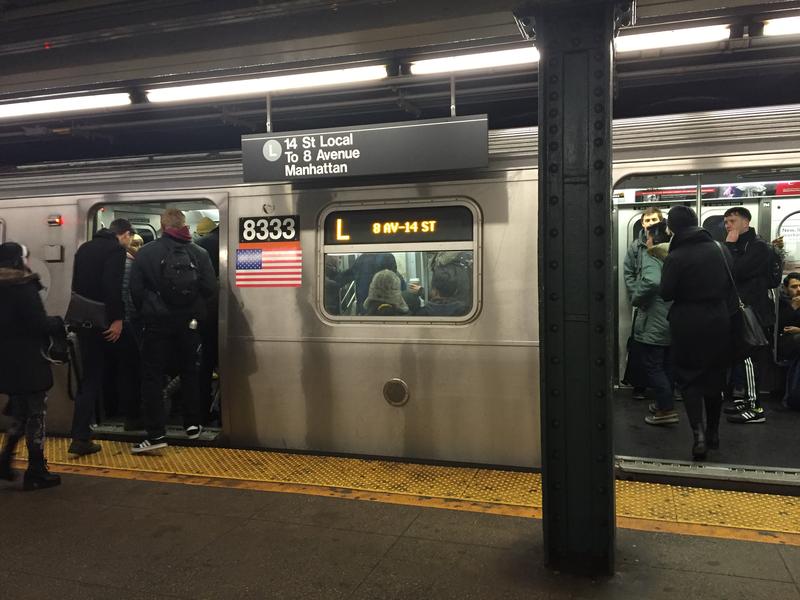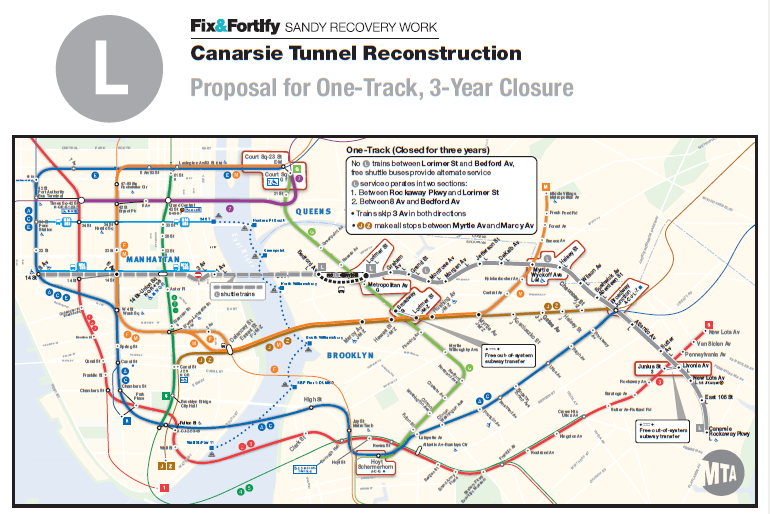 Transportation Nation
Transportation Nation
Come L or High Water: Sandy Damage Leaves MTA With Tough Choice

As subway-riding New Yorkers know, the system was dealt a huge blow during Sandy, when nine subway tunnels flooded with salt water.
"By far, the worst-damaged tunnel was Canarsie," said MTA president Tom Prendergast, naming the tunnel that carries the L train under the East River between Manhattan and Brooklyn. He said workers did what repairs they could, and flushed as much of the salt out as possible, in the days and weeks post-Sandy. "But salt remains, and so the corrosion continues. And there's a ticking clock with that."
Now, the MTA is preparing to make what it says are vital repairs: replacing the concrete that lines the cast-iron tunnel; rebuilding the concrete duct bank that runs alongside the tracks and carries electrical components, and installing new tracks and signals. (The MTA will also add entrances and elevators to the First Avenue and Bedford Avenue stations.) However, that requires the tunnel to shut down.
Here's where things get tricky.
At a meeting Thursday night, the MTA will present the public with two scenarios currently under consideration.
Option A is designed to be a shorter, if sharper, shock: full closure of both tracks in the tunnel for eighteen months, beginning in January 2019. This accelerates the work — but limits the L train service to Brooklyn only. "That's sort of the mantra 'get in, get done, get out,'" said New York City Transit head Ronnie Hakim.
Option B preserves some service by keeping one track open. But "some" is the operative word here. Because of the need to single-track through the tunnel, "we'd reduce our service by about 80 percent," said Hakim. Meanwhile, the length of the work doubles...to three years.
Under each scenario, subway service on nearby lines like the A, C, G, J, and M would be increased, and the G would run full-length trains. The MTA would also run extra bus service over the Williamsburg Bridge, create shuttle bus service within Brooklyn to nearby subway stops, and consider new ferry service from North 7th Street to 20th Street in Manhattan. And once passengers get off the ferry at 20th Street, Hakim said, they'll be greeted by new Select Bus Service, the MTA's brand of bus rapid transit. "SBS on steroids," as she put it, "to bring people where they want to go."
(Here's what's NOT on the table: closing the tunnel on weekends only. The silica dust that gets generated by destroying the old concrete raises air quality issues — workers have to use protective gear, but the stuff floats around for days and they can't run trains until they test the air. Nor will the MTA build a brand-new tunnel under the East River before taking the Canarsie tunnel out of service.)
"At the end of the day," said Hakim, "the one thing that's very clear to us is that we need to repair the tunnel. That work is a top priority. It needs to get done."
Transportation experts and transit advocates are leaning towards Option A. The Regional Plan Association said in a briefing memo that "the loss of the L train service to and within Manhattan for an 18-month period will be disruptive, but doubling the construction timeline, along with the higher associated costs and extending the pain of a huge service cut, is far less desirable."
Cate Contino, a coordinator with the Straphangers Campaign, agreed. "I as a rider would rather ‘quick and dirty,'" she said. "Get in, get out."
Four hundred thousand people use the L train on an average weekday, with about 225,000 going between Brooklyn and Manhattan.
MTA President Tom Prendergast said the agency will make a decision about which option to pick in two or three months.
More details about the L train work, as well as information about the MTA's two public meetings on the project, can be found here.
Previous articles:
L Train Shutdown? Wait for It. Then 'Boom!'
What the L: Residents Outraged By Possibility of Canarsie Tube Closure
MTA Chief: More Sandy-Related Subway Tunnel Closures Are Coming

